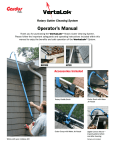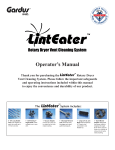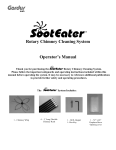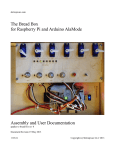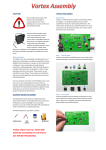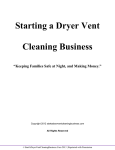Download LintGard Dryer Safety Monitor User Manual
Transcript
LintGard ™ Dryer Safety Monitor Helps Keep Your Dryer Working Safely & Efficiently Thank you for purchasing the LintGard “Dryer Safety Monitor”. The LintGard utilizes proven technology to accurately detect the back pressure in your dryer duct caused by lint build-up. Unlike other monitors that can produce false readings, the LintGard produces exact pressure readings for optimum dryer safety & efficiency. Please read all installation and operating instructions before use. Dryer Fires: The USFA (U.S. Fire Administration) found that clothes dryer fires account for about 15,600 structure fires, 15 deaths, and 400 injuries annually. “Failure to clean” is the leading factor contributing to clothes dryer fires in residential buildings. LintGard helps to ensure home safety and reduce energy costs by taking the guess work out of knowing when to clean your dryer vent. Here’s How the LintGard Works: Over time, lint builds up in your dryer vent system causing reduced airflow and increased back pressure. This reduced air flow results in longer drying times, higher utility costs and an increased risk of a dryer fire. The LintGard measures the back pressure caused by lint build up in your dryer duct. As the pressure increases, the gage oil moves up the scale (measured in “inches of water column”). Once the oil moves into the yellow or red zone, it’s time to clean your dryer vent. It requires no electricity or battery power to operate so you can enjoy years of trouble free operation while safely monitoring your dryer’s operation. Important Notes: Normal drying with a load of clothes in the drum and the dryer on a heat setting will lower the back pressure and produce inaccurate readings. For best results, be sure to check the “True Back Pressure” once a week by 1) cleaning the lint screen, 2) select the “fluff” cycle or “air only” cycle (no heat), 3) run dryer with “no clothes” in drum. Works on “Dual Motor” Dryers: The vast majority of dryers utilize “single motor” technology. However, a very small percentage of high end dryers use “dual motor” technology. The LintGard works on all types of dryers by testing “True Back Pressure” as stated above. INSTALLATION Before you start: Be sure your dryer vent system has been thoroughly cleaned from the back of the dryer to the outside termination hood. We recommend using the LintEater Rotary Dryer Vent Cleaning System for professional results. The LintEater has proven to be the leading dryer vent cleaning system. We also recommend the use of “All Metal” venting, either rigid or aluminum flex. If you have white vinyl or foil flex attached to your dryer, we strongly recommend you take this opportunity to replace it with “All Metal” venting. Cap Plug Vent Cap Tube Connection Fill Valve Step 1: Mounting the LintGard Monitor to the wall: 1.Choose a visible location on the back wall above dryer or on the side wall near dryer if space is limited on back wall. Note: The LintGard monitor must be mounted at least 2 feet away from “VentTap” fitting. Main Reservoir Storage Reservoir Clear Sight Tube Zero Adjust Knob 2.Install screw in top hole of monitor until snug. Do Not Tighten. 3.Level monitor by centering bubble between lines on level vial. 4.Install second screw in center of bottom hole. Tighten mounting screws while holding monitor level. Re-level if necessary. 5.Fill “Main Reservoir” by: -Loosen “Cap Plug” 1½ turns by turning counterclockwise . -Open “Fill Valve” by turning counterclockwise 2 full turns. Oil will flow from Storage Reservoir to Main Reservoir. Note: If oil does not appear in “Clear Sight Tube,” loosen plug more. -Close “Fill Valve” when gage oil stops rising in “Clear Sight Tube.” Tighten securely by hand. -Close “Cap Plug.” Tighten securely by hand. 6.Use “Zero Adjust Knob” to fine adjust oil level to zero. - Turn knob “Counter Clockwise” to “Decrease” oil level in “Clear Sight Tube.” - Turn knob “Clockwise” to “Increase” oil level. Step 2: Attach VentTap Fitting: 1.Disconnect dryer duct from back of dryer. 2.Use pointed object or 5/16 drill bit to make hole in duct close to dryer as shown (within 12 inches from back of dryer). Install VentTap on “top” of vent for horizontal installations. Needle nose pliers work best for making hole in aluminum flex by twisting pliers back & forth while applying slight pressure. Note: Be sure hole does not interfere with reconnection of exhaust duct to back of dryer. 3.Install VentTap fitting through vent, place felt washer on outside of vent then plastic washer. Tighten nut securely. 4.Press tubing onto VentTap fitting. Step 3: Connect Clear Tube to LintGard Monitor: 1. Extend the clear tubing up to the port on the side of the LintGard monitor. Trim length of tubing to eliminate any sag in tubing (see Figure 1). This prevents condensation from building up in the tubing which may cause the tube to become blocked or restricted. Before trimming tube, be sure to leave enough length to connect to port. 2. Hold monitor firmly while pressing tube onto port. Use a circular motion while pressing tube onto port. Important Note: The LintGard must be mounted at least 2 feet away from “VentTap” fitting. OPERATING THE LINTGARD 1.Be sure dryer exhaust duct has been thoroughly cleaned and any repairs made to eliminate restrictions in venting system. 2.Clean lint screen 3.Select “Fluff” cycle or “Air Only” cycle on dryer. (no heat) 4.Run dryer with “No Clothes” in drum. 5.Record the reading in the “back pressure log” at back of manual. Be sure to record the date as well. This will help determine the average time intervals between cleanings. 6.Mark reading on clear gage tube using a ball point pen or fine tip marker. 7.Check ‘true back pressure” readings once a week by repeating steps 2 through 4. Important Notes: 1.Readings during normal dryer use are “Not” “true back pressure” readings and should not be used to determine when the vent system needs to be cleaned since the back pressure in the exhaust duct is affected (lowered) by heat from dryer and clothes in drum. 2.Only “true back pressure” readings should be used for monitoring lint build-up. 3.It is normal for the red gage oil to pulsate up and down slightly in clear gage tube during normal use. This is due to the weight of the clothes in the drum slowing the drum and motor as it rotates. This same motor also spins the blower; therefore, the blower slows and speeds up at the same rate as the drum resulting in changing back pressure. When to clean your dryer exhaust duct: Vent Tap Fitting 2 ft. Minimum Length Normal initial “clean” readings are in the range of .1 – .6 inches of water column. If your “clean” reading is within this range, consider cleaning as the “true back pressure” readings rise into the yellow zone. Cleaning should be completed before reaching the red zone. If your initial “clean” reading is above .6 inches of water column, you will need to clean your dryer’s exhaust duct more often. Cleaning should be performed when your initial “clean” reading increases by .1 to .2 inches of water column. Example: If your initial “clean” reading is .7 inches of water column, consider cleaning the exhaust duct when the “true back pressure” reading reaches .8 to .9 inches of water column. Again, be sure to check the true back pressure readings once a week. FIGURE 1 Incorrect Correct D AT E READING D AT E READING D AT E READING FAQ’S QUES TION A N S WE R What if monitor reading is “zero” or oil does not move up “Sight Tube” when dryer is running? Remove clear tube from side of monitor. Blow into tube. This should clear any blockage. Reconnect tube to port by pressing firmly. What if oil does not reach “zero” on scale and the knob is fully adjusted in? After a long period of time, it may be necessary to add oil. Please call 888-9850208 to order. What precautions should I take if I relocate the monitor? When moving the LintGard to another location, be sure to follow the steps below before removing unit from wall. 1. Remove Vent Cap on top of monitor by prying up with small screwdriver. 2. Remove clear tube from port on side of unit. 3. Connect a short piece of tubing from port on side of unit to port on top of unit. This will contain the gage oil and prevent spillage. Limited Warranty The LintGard is to be used only as a gage to determine back pressure in dryer vent systems caused by lint build-up or other restrictions. Its only purpose is to provide a visual guide to help determine when the dryer exhaust duct should be cleaned. The LintGard and all components are warranted for a period of one year from date of purchase. Should any part fail due to a manufacturing defect, return the defective part to Gardus, Inc. and we will repair or replace it free of charge once the unit is confirmed to be defective. Please call 203-985-0208 for a return authorization number prior to returning any item. The terms of this warranty shall not exceed the replacement cost of the LintGard. Gardus, Inc. does not warranty failure of any part due to operator error. Be sure to read all installation and operating instructions before use. Gardus, Inc. and any of its subsidiaries accept no liability for property damage or personal injury due to the operation or failure of the LintGard and accessories. This is the full extent of the warranty made by Gardus, Inc. All implied warranties are hereby excluded.. CAUTION: RED GAGE OIL (0.826 SPECIFIC GRAVITY) > Avoid contact with red gage oil contained within the LintGard monitor. > If contact with skin occurs, wash with soap and water. > Mild eye irritant. If contact occurs, flush eyes with water. Get medical attention. > If swallowed, do “not” induce vomiting. Get medical attention. > Keep Out of Reach of Children MADE IN CHINA







